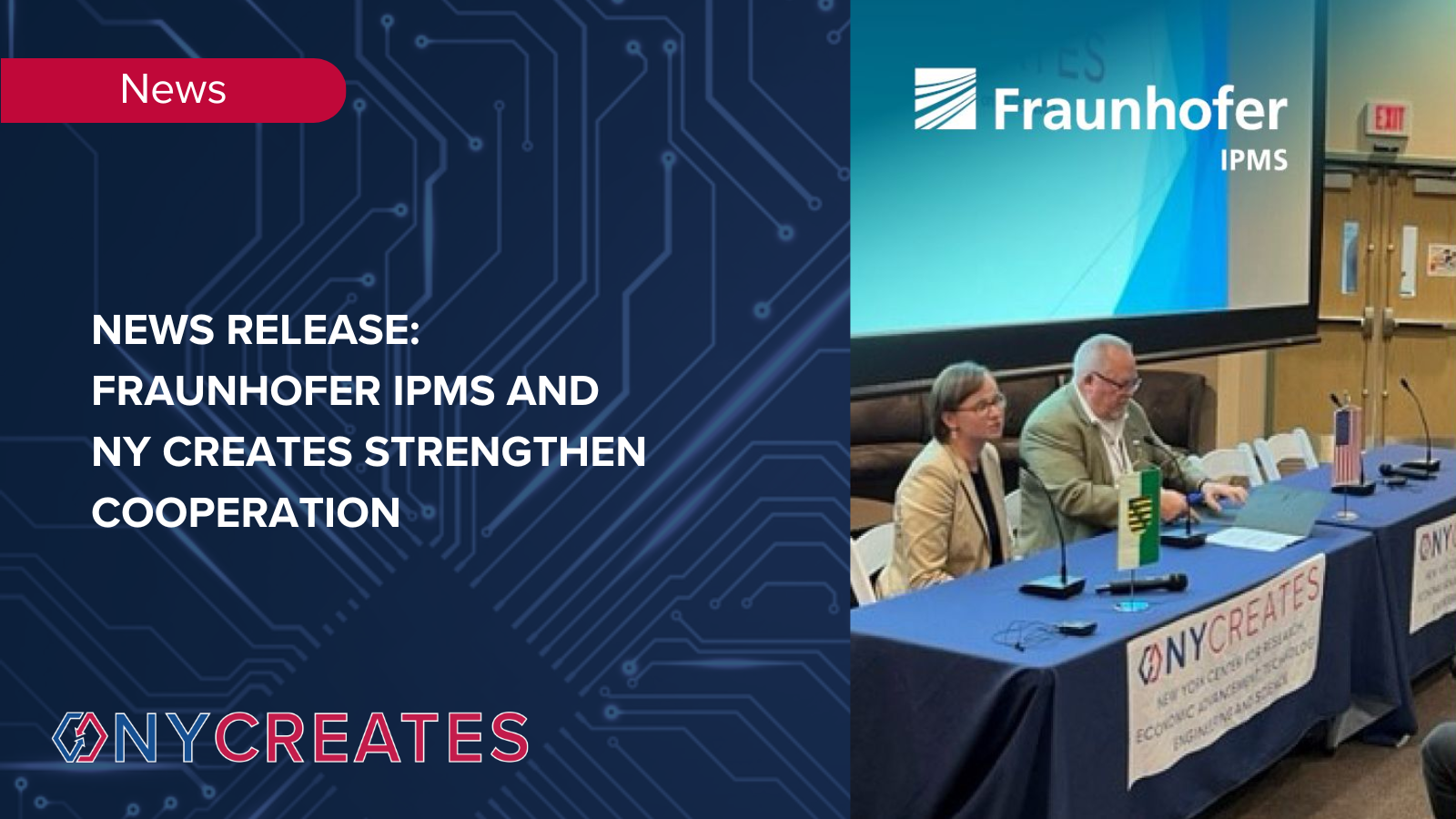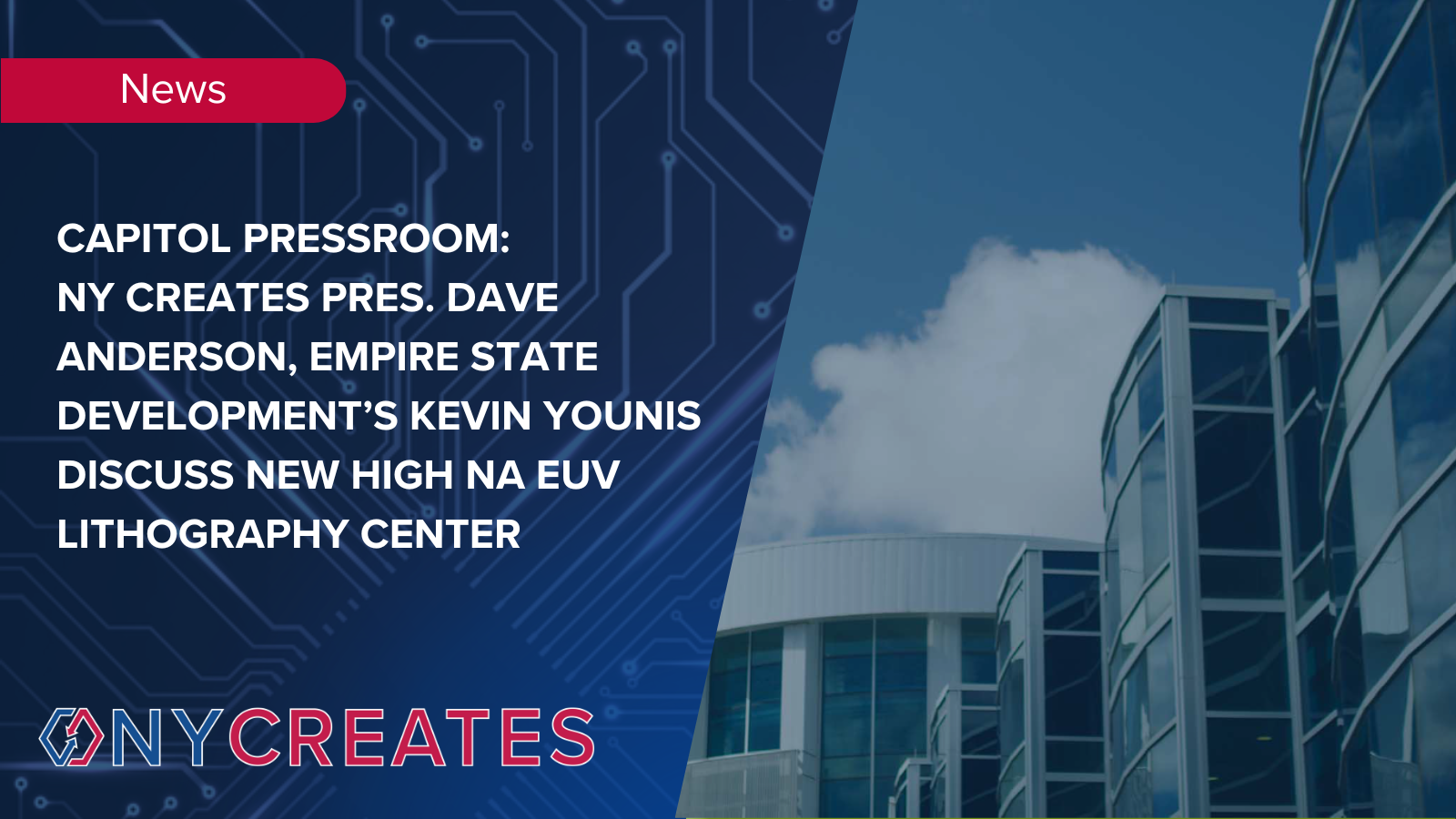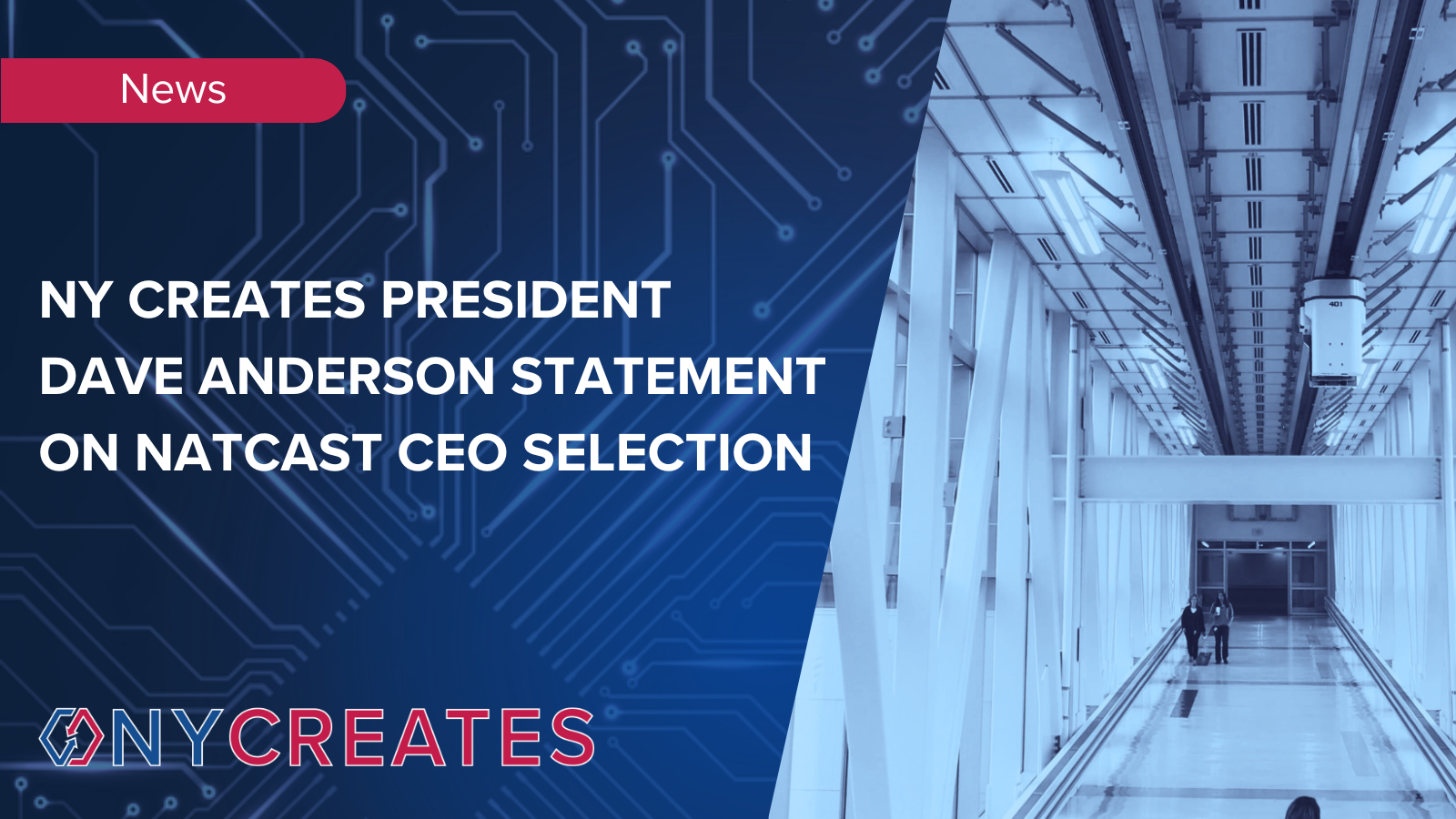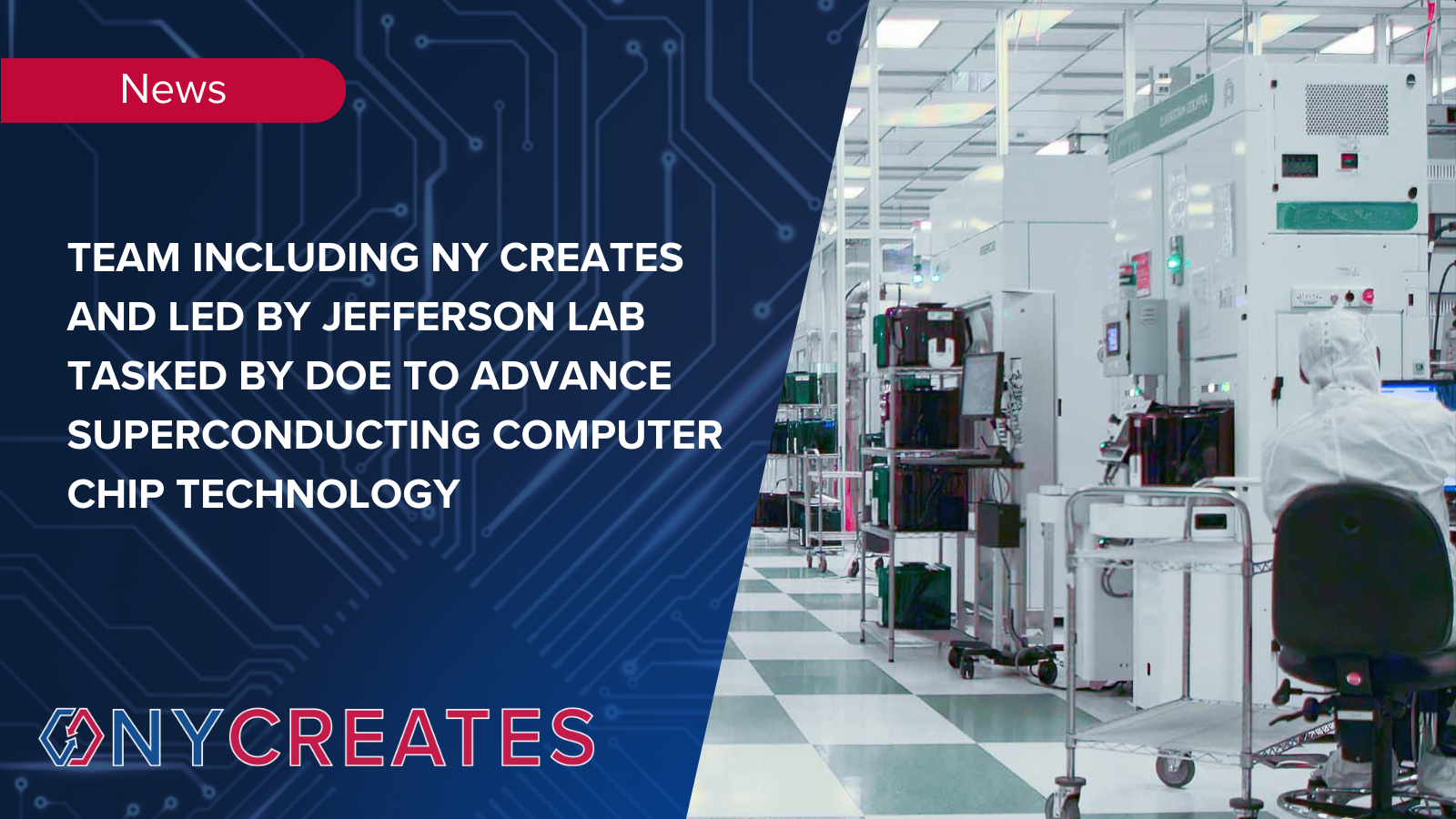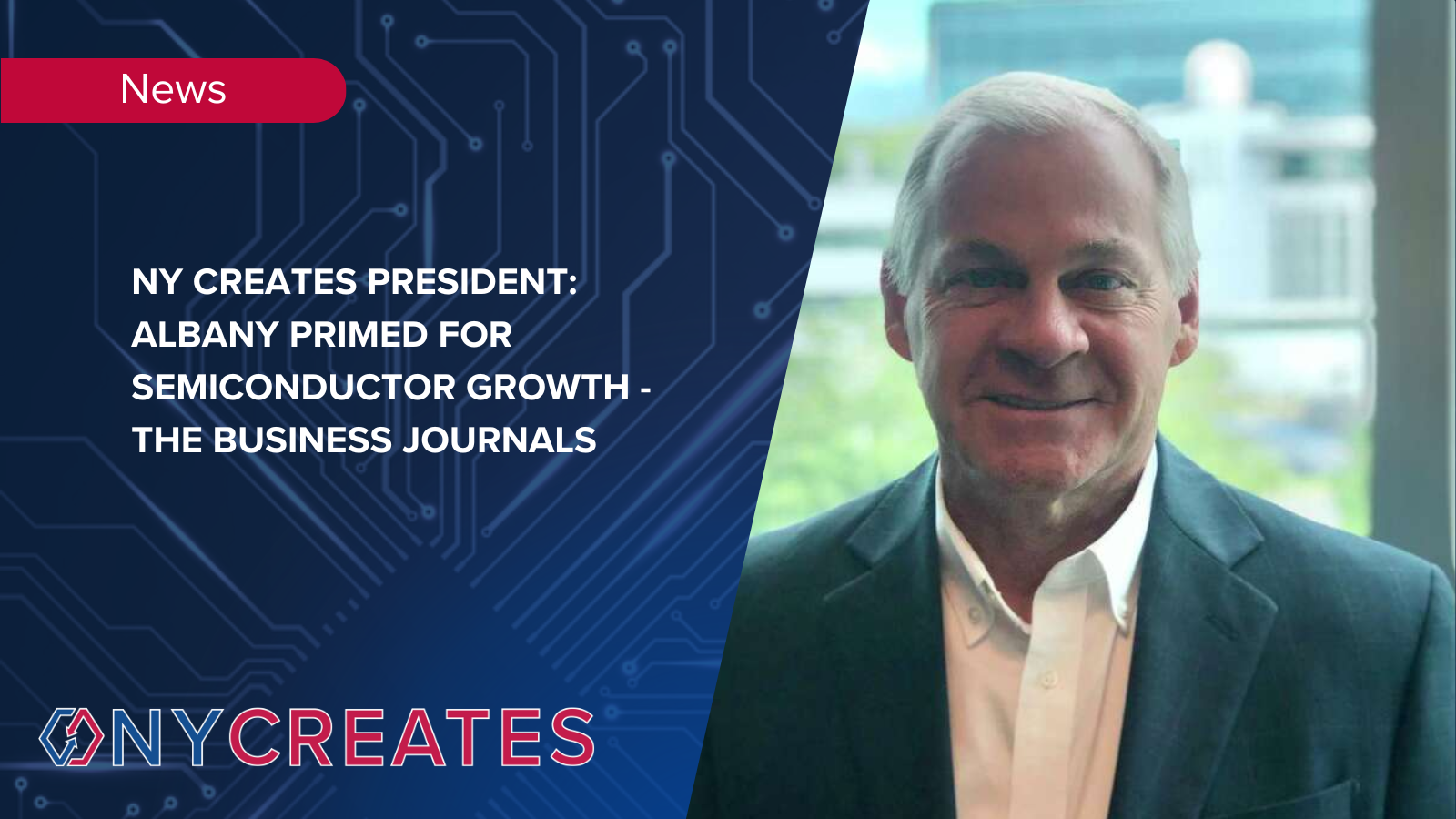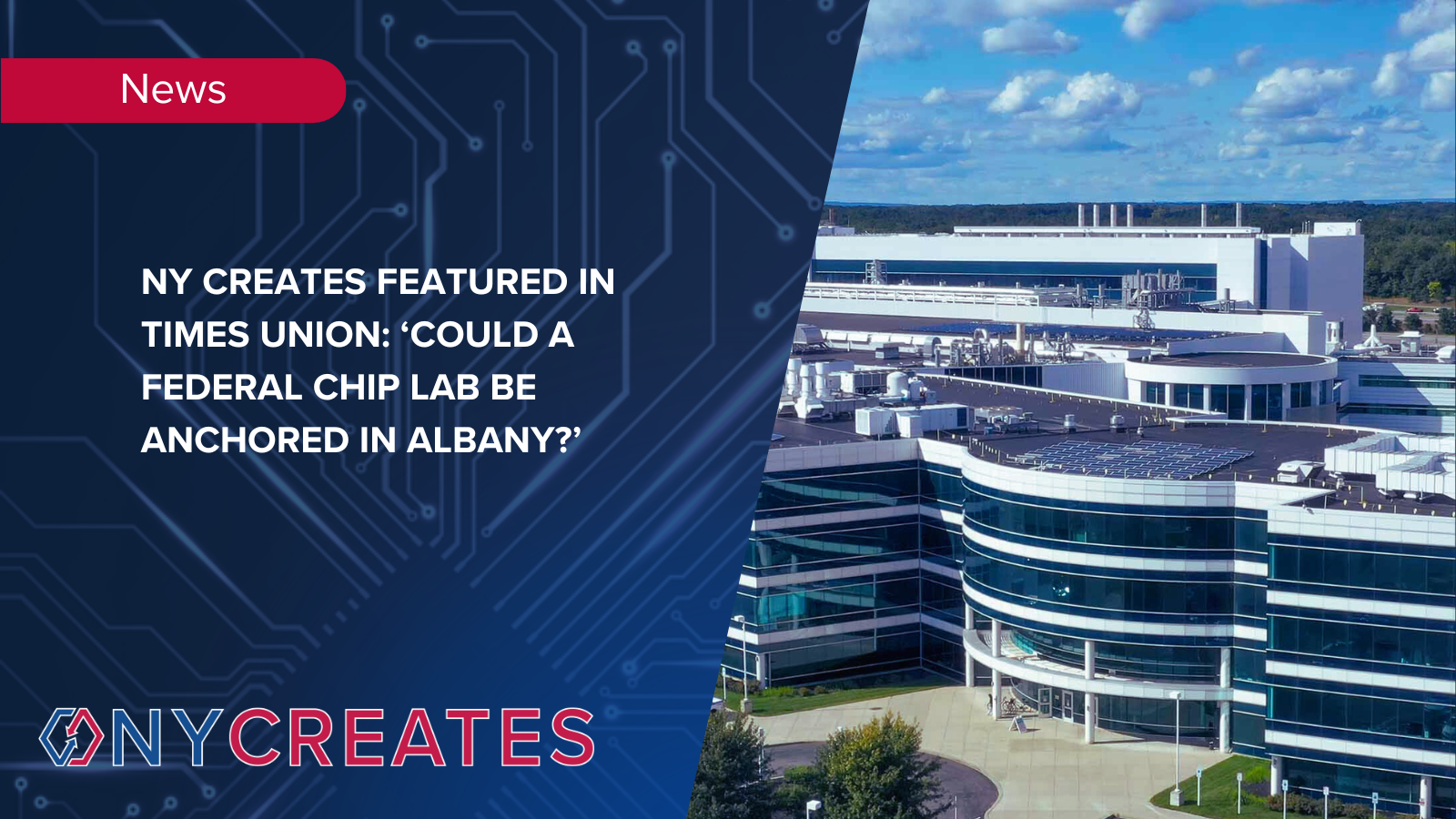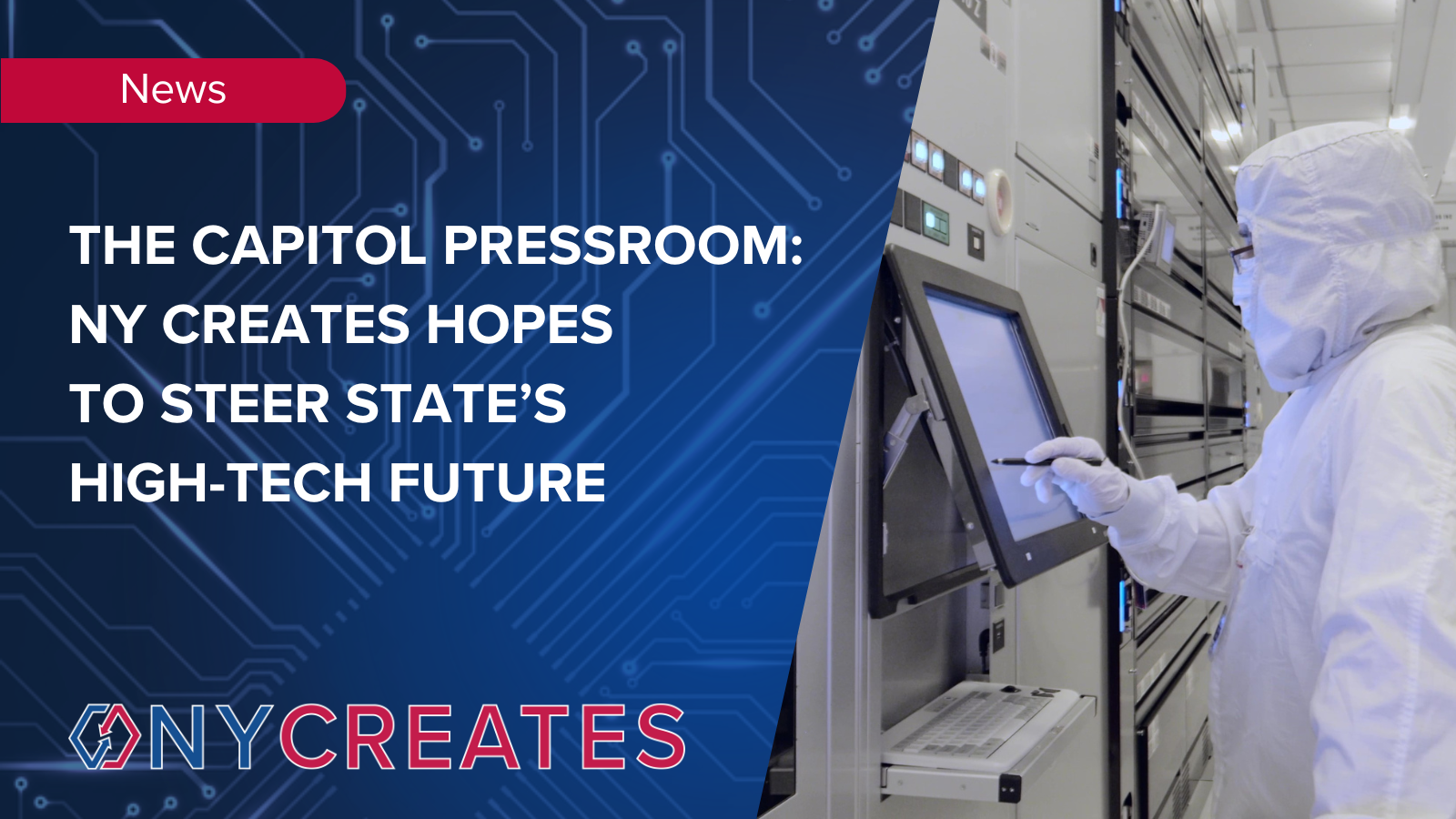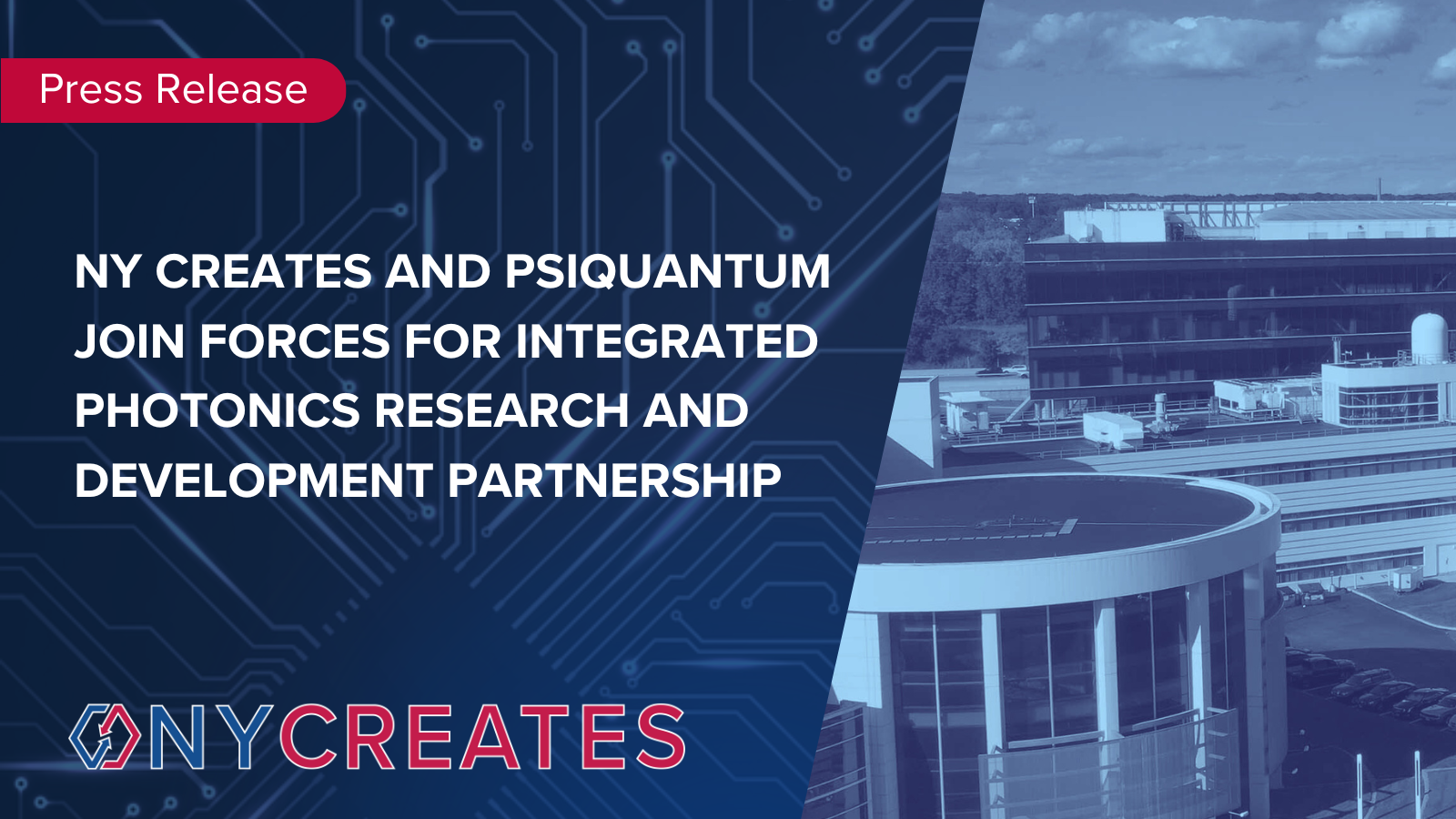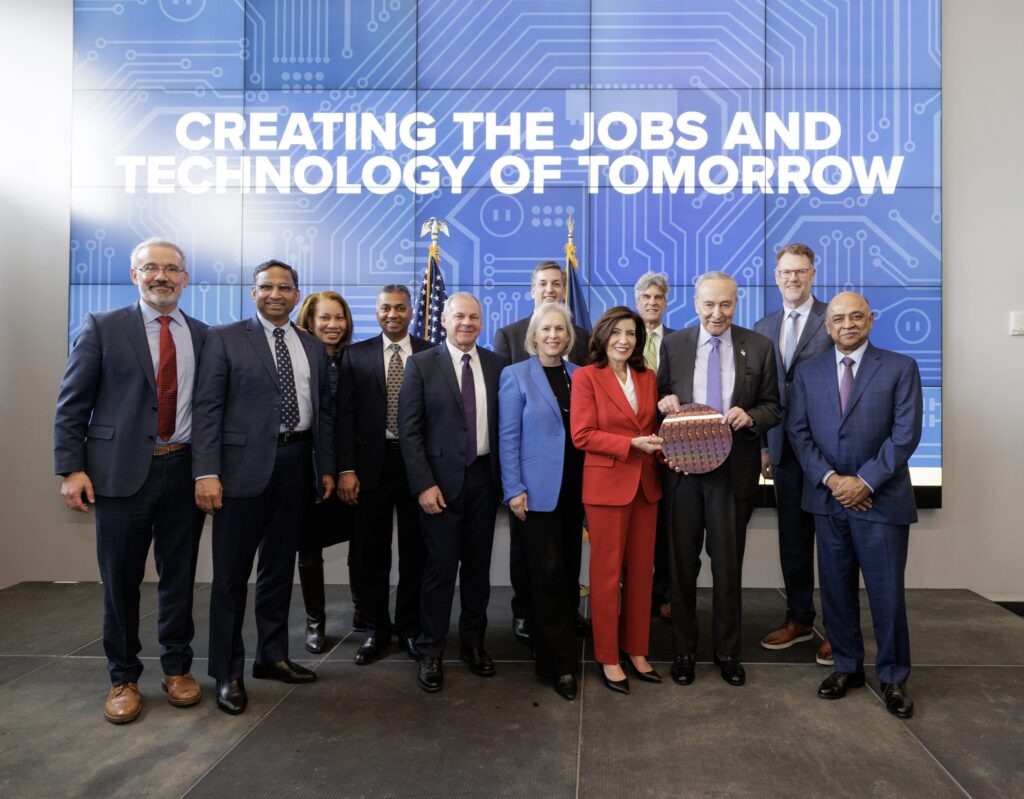
December 11, 2023
Albany NanoTech Will House North America’s First and Only Publicly Owned High NA Extreme Ultraviolet Lithography Center – Bringing the Future of Advanced Semiconductor Research & Manufacturing to New York’s Capital Region
Project Will Unlock Transformative Benefits Including Thousands of New Direct, Indirect, and Union Construction Jobs and Strong Commitments to Workforce Development and Sustainability
Partnership Includes Significant Private Investment From IBM, Micron, Applied Materials, Tokyo Electron and Other Industry Leaders That Will Integrate Cutting-Edge Chipmaking Technology into Their R&D Efforts
Builds on Governor Hochul’s Agenda to Establish a Global Hub for Semiconductor Manufacturing and Innovation Upstate
Governor Kathy Hochul today announced a $10 billion partnership with leaders from the semiconductor industry such as IBM, Micron, Applied Materials, Tokyo Electron, and others to establish a next-generation semiconductor research and development center at NY CREATES’ Albany NanoTech Complex. The partnership will fund the construction of a cutting-edge High NA Extreme Ultraviolet Lithography Center – the first and only publicly owned High NA EUV Center in North America – that will support the research and development of the world’s most complex and powerful semiconductors. In addition to the transformative investment in New York’s Capital Region, this partnership will make New York State home to the nation’s most advanced, publicly owned semiconductor R&D infrastructure, support the long-term growth of New York’s tech economy, and create and retain thousands of direct, indirect, and union construction jobs.
“This $10 billion partnership to bring innovative chips research to the Capital Region should send a message to the entire industry: New York is open for business,” Governor Hochul said. “From our Green CHIPS legislation to Micron’s historic investment and the creation of GO-SEMI, we’re building the future of semiconductor research right here in New York. This industry is creating real opportunity in our state with major regional investments, countless new jobs, and bold commitments to workforce development and sustainability, and my administration will keep working with elected and industry leaders to make New York a global chipmaking superpower.”
Under this new initiative, NY CREATES will acquire and install a High NA EUV lithography tool, designed and manufactured by ASML, at its Albany NanoTech Complex, where industry partners including Micron, IBM, Applied Materials, Tokyo Electron, and others will use the most advanced semiconductor equipment ever made. Once built, New York’s High NA EUV Center will position the state as a destination for research and development of the innovative chip technology that powers nearly every smartphone, tablet, laptop, and computer server today. The Center will also foster international partnerships as world-renowned research organizations expand their presence here, drawing businesses from around the globe.
In addition, this partnership will significantly enhance New York State’s position as a leading candidate to secure anchor hub status under the federal National Semiconductor Technology Center, a designation with the potential to unlock more than $11 billion in federal CHIPS and Science Act funding.
This project will create at least 700 new direct jobs and retain thousands of jobs, leverage at least $9 billion in private spending and investment, and establish significant commitments to support and build talent development pipelines, including through partnerships with the State University of New York. Partners have committed to either expanding or initiating support for workforce development programming, including investments in SUNY, Rensselaer Polytechnic Institute, and other public and private workforce development activities; K-12 STEM academic programs; training, internships, and experiential learning to undergraduate and graduate students in engineering and related STEM fields, and academic research partnerships.
NY CREATES and industry partners have also agreed to a range of sustainability commitments throughout the construction and operational phases of the project that are closely aligned with New York’s nation-leading Green CHIPS program, including use of best available technology for greenhouse gas emission reduction; prioritization of renewable energy, with preference for New York sources; and pursuit of minimum Gold LEED status certification for new buildings related to the project. Additionally, partners are committed to integrating sustainability as a primary goal of R&D activities, including sustainable semiconductor manufacturing processes, materials use, waste reuse and reclamation, and fab design. Through this new focus, the High NA EUV Center is positioned to become a global leader in the development of sustainable and climate-friendly semiconductor manufacturing processes and technology.
To support this project, New York State is investing $1 billion to expand the Albany NanoTech Complex with the establishment of the High NA EUV Center through the purchase of ASML’s EXE:5200 High NA EUV scanner, as well as the construction ofNanoFab Reflection, a new, highly sophisticated building with more than 50,000 sq. ft. of cleanroom space that will encourage future partner growth and support new initiatives like the National Semiconductor Technology Center, National Advanced Packaging Manufacturing Program, and Department of Defense Microelectronics Commons program, the latter of which was recently awarded to New York State. The project will create an estimated peak of 500 to 600 union construction jobs at prevailing wage during the two-year construction phase.
The project is critical to further growing NY CREATES’ Albany NanoTech Complex. In addition to creating 50,000 square feet of state-of-the-art cleanroom space at Albany NanoTech, it is anticipated that this investment opens the door to the construction of additional future cleanroom space to enable the projected long-term growth of new and existing collaborations spurred by the High-NA EUV Center and federal initiatives.
Senate Majority Leader Chuck Schumer said, “This is a landmark day for the Capital Region. With this groundbreaking $10 billion public-private partnership, spurred by my CHIPS and Science Act, industry has made it clear: the Albany NanoTech Complex is home to America’s semiconductor R&D future. This historic partnership will bring the most cutting-edge machinery in the world to Upstate NY, helping make discoveries that engineers today cannot even fathom – ensuring the U.S. leads the world in semiconductor innovation and manufacturing and bringing us closer to turning science fiction into reality by producing microchips smaller than a nanometer, right here in the Capital Region. This $10 billion means hundreds of new high-paying tech and construction jobs, along with scientists and leading companies from around the world turning to the Capital Region as the place where they conduct their research. I wrote the CHIPS & Science Act because I knew it would be transformative for Upstate New York, which was perfectly suited to bring this industry that is vital to America’s national security and economic future back from overseas. Under Governor Hochul’s leadership, New York has not only answered the call put out by the feds, but helped create a national model with unprecedented investment in every corner of Upstate NY and today’s announcement is just the latest example of how New York is leading our nation in developing the next generation of technology.”
Senator Kirsten Gillibrand said, “This investment in Albany NanoTech will reinforce New York’s position as a global leader in semiconductor research and development. This next-generation research and development center will be the only facility of its kind in the Western Hemisphere and will draw in major businesses from around the world, grow the state’s tech economy, and potentially unlock billions in federal investments to the Capital Region. Establishing this new semiconductor center will also bolster our national security, allowing the United States to develop the world’s most complex and powerful semiconductors right at home. I am proud to see this partnership come to life and look forward to continuing to work to make the Capital Region a global leader in semiconductor research and manufacturing.”
Representative Paul Tonko said, “I’ve long pushed for strong investments in our chips manufacturing to strengthen our domestic supply chains, create good-paying jobs, and lower costs for American consumers. Thanks to that effort and provisions in our CHIPS and Science Act, our Capital Region – already home to a robust network of chip manufacturers, state of the art research facilities, and educational institutions – is poised to lead the nation in this sector, driving innovation and strengthening our economy. This partnership builds upon the pioneering spirit of innovation that our region has long represented. I’m grateful to all those whose dedication is enabling further development and growth in this industry.”
IBM Chairman and CEO Arvind Krishna said, “At the New York State Albany NanoTech Complex, IBM and our partners are leading the world in semiconductor R&D advances that make chips smaller, more powerful, and more energy efficient. The new High NA EUV Center at Albany NanoTech will secure a strong pipeline for semiconductor innovation, keeping New York State at the center of semiconductor expertise, accelerating the growth of the global chip industry and helping to meet manufacturing demand for new technologies such as generative AI. IBM is proud to call New York State our home, and to support this critical investment towards new breakthroughs in semiconductor technology.”
Micron President and CEO Sanjay Mehrotra, said, “The High NA EUV Center at NY CREATES’ Albany NanoTech Complex is a critical step in advancing next-generation semiconductor R&D in America and will put New York at the forefront of future innovation and technology leadership. One of the key factors that made New York the ideal future home for our megafab was the state’s history of semiconductor development and manufacturing and the strong opportunities for R&D ecosystem collaboration that Micron can help scale with our memory technology leadership. Alongside our state and federal partners and with critical funding support from the CHIPS and Science Act, we look forward to building and training a highly skilled talent pipeline through North America’s first and only High NA EUV Center.”
Semiconductor Products Group at Applied Materials President Prabu Raja said, “We are pleased to see continued investments to strengthen the chipmaking R&D ecosystem in New York State. At our Materials Engineering Technology Accelerator (META Center) at Albany NanoTech, Applied is collaborating with customers to pioneer new semiconductor materials, structures and devices for improving chip performance and energy efficiency. Expanding the footprint and capabilities of the NanoTech campus will build upon our longstanding partnership with New York State and provide another avenue to accelerate the time from concept to commercialization of next-generation chipmaking technologies.”
Tokyo Electron (TEL) President and CEO Tony Kawai said, “We are looking forward to continuing our decades-long partnership with New York State through the opening of the new R&D center at the Albany NanoTech Complex. High NA EUV is the semiconductor industry’s most advanced manufacturing technology, and TEL is excited to contribute to the development of the global semiconductor industry and the innovation in this space that this new development will spur.”
ASML President and CEO Peter Wennink said, “We are proud that ASML tools enable our customers to produce the chips the world needs. This significant investment by New York in cutting-edge High NA EUV technology will fuel innovation in our ecosystem and accelerate chipmakers’ ability to manufacture tomorrow’s more advanced chips faster and more cost-effectively.”
Establishing a Global Semiconductor Hub in New York State
Governor Hochul has maintained a strong commitment to building a modern economy in New York State by growing the semiconductor industry and attracting innovative businesses that create good paying, 21st century jobs. In October 2022, after signing New York’s first-in-the-nation Green CHIPS legislation to build a thriving, sustainable chips industry, the Governor announced an historic $100 billion investment from Micron to establish a state-of-the-art leading-edge memory manufacturing campus in Central New York that will create 50,000 jobs. Since signing Green CHIPS, the Governor has also announced major investments from several other semiconductor manufacturers and companies from the semiconductor supply chain, including AMD, Edwards Vacuum, and TTM Technologies to expand their presence in New York.
In her 2023 State of the State address, Governor Hochul announced the creation of the $45 million Governor’s Office of Semiconductor Expansion, Manufacturing, and Integration, known as GO-SEMI, to oversee the state’s efforts to continue to grow the industry.
New York’s Albany NanoTech Complex
The Albany NanoTech Complex, owned and operated by the non-profit New York Center for Research, Economic Advancement, Technology, Engineering, and Science, or NY CREATES, is the most advanced, publicly-owned 300 mm semiconductor R&D facility in North America and has been at the forefront of semiconductor innovation for more than two decades. The site currently houses the current generation of EUV lithography equipment, which IBM recently used to produce the world’s first 2 nanometer chip technology – the smallest scale ever developed. The High NA EUV Center will bring the next generation of EUV equipment to Albany NanoTech and firmly establish New York as the epicenter of leading-edge semiconductor R&D.
Empire State Development President, CEO and Commissioner Hope Knight said, “New York State has invested billions of dollars over the last several years to make Albany NanoTech the most advanced publicly owned semiconductor research and development center in North America and this is the next step in its evolution. This investment will literally catapult New York State to the forefront of semiconductor R&D and continue our efforts to make New York State the semiconductor capital of the nation. We are also ensuring that sustainability and workforce development opportunities are a priority so that the next generation of New Yorkers are well placed for opportunities in this industry.”
NY CREATES President Dave Anderson said, “Governor Hochul’s vision to make New York State the epicenter for semiconductor-based R&D is undoubtedly coming to fruition as a result of today’s historic investment by New York and our industry partners. This funding will support construction of the new NanoFab Reflection building at NY CREATES’ Albany NanoTech Complex to house the world’s most advanced, next-generation extreme ultraviolet lithography equipment. As a result of this historic investment, under the leadership of Governor Hochul and the continued and tireless support from Senate Majority Leader Schumer, NY CREATES and our partners will secure our place at the forefront of global chip development for years to come. This expansion sets the stage for long-term growth and new job opportunities here and throughout the state, contributing significantly to the nation’s innovation economy and demonstrating why the Albany NanoTech Complex is ready to host the critically important National Semiconductor Technology Center.”
Imec President and CEO Luc Van den hove said, “Imec is pleased to support the High NA EUV Center to be set up at the Albany NanoTech Complex. This initiative will speed up the industrial adoption of the most advanced semiconductor manufacturing technology in the U.S. The introduction of High NA EUV needs radical innovations on the process side. To anticipate this in a proactive way, imec has set up a joint high-NA EUV lab with ASML, built around the very first high-NA scanner. Working closely with the global patterning ecosystem, we are preparing the process innovations and de-risking the technology. and we are eager to work with the partners at NY CREATES on this complementary strategic effort to push the boundaries of chip scaling and performance.”
News Coverage

